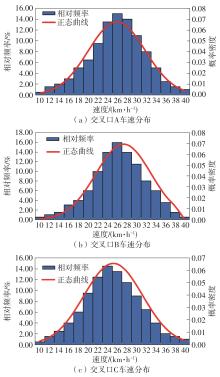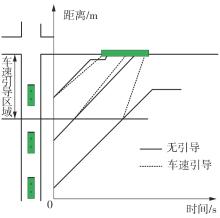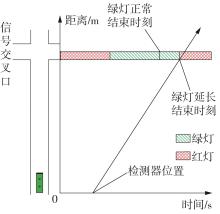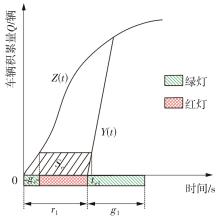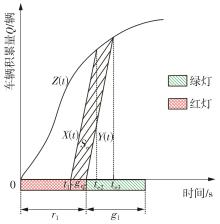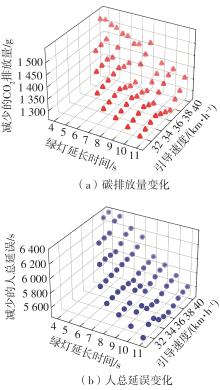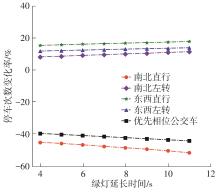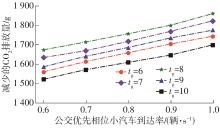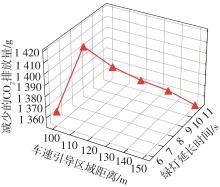Journal of South China University of Technology(Natural Science Edition) ›› 2023, Vol. 51 ›› Issue (10): 160-170.doi: 10.12141/j.issn.1000-565X.230178
Special Issue: 2023绿色智慧交通系统专辑
• Green, Intelligent Traffic System • Previous Articles
Optimization Model of Bus Priority Control Considering Carbon Emissions with Stochastic Characteristics
HU Xinghua1 CHEN Xinghui1 WANG Ran2 LONG Bing3 WU Jiang4
- 1.School of Traffic &Transportation,Chongqing Jiaotong University,Chongqing 400074,China
2.Chongqing YouLiang Science & Technology Co. ,Ltd. ,Chongqing 404100,China
3.Chongqing Transport Planning Institute,Chongqing 401120,China
4.Chongqing Shengyuan Engineering Design Consulting Co. ,Ltd. ,Chongqing 400023,China
-
Received:2023-06-06Online:2023-10-25Published:2023-06-06 -
Contact:陈兴辉(1998-),男,硕士生,主要从事区域及城市交通运输系统规划研究。 E-mail: cxh_19981008@163.com -
About author:胡兴华(1981-),男,博士,教授,主要从事交通碳排放大数据分析及绿色低碳政策、区域及城市交通运输系统规划研究。E-mail: xhhoo@cqjtu.edu.cn -
Supported by:the Sichuan Science and Technology Project(2022YFG0132);the Chongqing Postgraduate Joint Training Base Project(JDLHPYJD2019007);the Chongqing Social Science Planning Project(2021NDYB035)
CLC Number:
Cite this article
HU Xinghua, CHEN Xinghui, WANG Ran, et al. Optimization Model of Bus Priority Control Considering Carbon Emissions with Stochastic Characteristics[J]. Journal of South China University of Technology(Natural Science Edition), 2023, 51(10): 160-170.
share this article
Table 1
Solution steps of Gauss-Seidel algorithm"
| 算法:Gauss-Seidel |
|---|
步骤1 固定上层模型的决策变量 步骤2 定义 步骤3 如果 步骤4 计算满足 步骤5 如果 步骤6 小循环终止准则为:如果j>z,p=p+1,执行步骤7,否则返回步骤3。 步骤7 优化上层模型决策变量,暂时固定下层模型中的决策变量,对上层模型中的决策变量进行对角化迭代,更新 步骤8 大循环收敛准则为:如果 步骤9 将求得的未知变量 |
Table 4
Fitting coefficients of vehicle accumulation function at intersection"
| 进口道方向 | 多项式系数 | b1/10-6 | b2/10-3 | b3/10-3 | b0/10-2 | R2 |
|---|---|---|---|---|---|---|
| 多项式基函数次数 | x3 | x2 | x | 1 | ||
| 南进口道 | 直行 | -7.34 | 24.30 | -168.00 | 1.73 | 0.968 |
| 左转 | -12.30 | 3.38 | 43.70 | -10.10 | 0.967 | |
| 北进口道 | 直行 | -43.80 | 21.90 | -25.70 | 30.30 | 0.984 |
| 左转 | -13.20 | 4.46 | 1.67 | -23.40 | 0.964 | |
| 东进口道 | 直行 | -7.68 | 3.57 | 42.80 | 2.37 | 0.958 |
| 左转 | -23.60 | 1.07 | 19.30 | -38.20 | 0.972 | |
| 西进口道 | 直行 | -7.28 | 2.58 | 46.70 | 25.80 | 0.967 |
| 左转 | -21.60 | 1.73 | 24.30 | 6.37 | 0.958 |
| 1 | LI J, LIU Y, ZHENG N,et al .Regional coordinated bus priority signal control considering pedestrian and vehicle delays at urban intersections[J].IEEE Transactions on Intelligent Transportation Systems,2021,3(2):85-103. |
| 2 | XU T, BARMAN S, LEVIN M W,et al .Integrating public transit signal priority into max-pressure signal control:methodology and simulation study on a downtown network[J].Transportation Research Part C:Emerging Technologies,2022,138:103614. |
| 3 | 宋现敏,冷宁,姜景玲 .车联网环境下基于可变相位的公交优先信号控制方法[J].华南理工大学学报(自然科学版),2021,49(5):18-27. |
| SONG Xianmin, LENG Ning, JIANG Jingling .Bus priority signal control method based on variable phase in internet vehicles environment[J].Journal of South China University of Technology (Natural Science Edition),2021,49(5):18-27. | |
| 4 | CEYLAN H, BELL M G H .Traffic signal timing optimization based on genetic algorithm approach,including drivers’routing[J].Transportation Research Part B:Methodological,2020,38(4):329-342. |
| 5 | Liu J, Lin P, Ran B .A reservation-based coordinated transit signal priority method for bus rapid transit system with connected vehicle technologies[J].IEEE Intelligent Transportation Systems Magazine,2020,13(4):17-30. |
| 6 | 欧诗琪,俞春辉,马万经 .干线信号协调背景下的网联公交实时优先控制方法[J].同济大学学报(自然科学版),2022,50(3):339-350. |
| Shiqi OU, YU Chunhui, MA Wanjing .Connected bus real-time priority control considering arterial signal coordination[J].Journal of Tongji University (Natural Science),2022,50(3):339-350. | |
| 7 | KWAK J, PARK B, LEE J .Evaluating the impacts of urban corridor traffic signal optimization on vehicle emissions and fuel consumption[J].Transportation Planning and Technology,2019,35(2):145-160. |
| 8 | KAREKLA X, FERNANDEZ R, TYLER N .Environmental effect of bus priority measures applied on a road network in santiago,chile[J].Transportation Research Record,2018,2672(8):135-142. |
| 9 | HALLMARK S L, FOMUNUNG I, GUENSLER R,et al .Assessing impacts of improved signal timing as a transportation control measure using an activity-specific modeling approach[J].Transportation Research Record,2020,1738(1):49-55. |
| 10 | 刘畅,魏丽英 .考虑人均延误和人均排放的信号配时优化模型[J].哈尔滨工业大学学报,2018,50(9):83-88. |
| LIU Chang, WEI Liying .Signal timing optimization model considering per capita delay and per capita emissions[J].Journal of Harbin Institute of Technology,2018,50(9):83-88. | |
| 11 | HU X, CHEN X, GUO J,et al .Optimization model for bus priority control considering carbon emissions under non-bus lane conditions[J].Journal of Cleaner Production,2023,402:136747. |
| 12 | 彭飞,宋国华,尹航,等 .面向实际交通状态的混合动力汽车能耗和CO2排放模型[J].交通运输系统工程与信息,2022,22(6):316-326. |
| PENG Fei, SONG Guohua, YIN Hang,et al .Energy consumption and co2 emission model for hybrid vehicles in real traffic conditions[J].Journal of Transportation Systems Engineering and Information Technology,2022,22(6):316-326. | |
| 13 | 徐龙,王力,刘莹,等 .基于多源数据的公交车能耗碳排放测算模型[J].交通运输系统工程与信息,2020,20(3):174-181. |
| XU Long, WANG Li, LIU Ying,et al .Calculation model of bus energy consumption and co2 emission based on multi-source data[J].Journal of Transportation Systems Engineering and Information Technology,2020,20(3):174-181. | |
| 14 | THODI B T, CHILUKURI B R, VANAJAKSHI L .An analytical approach to real-time bus signal priority system for isolated intersections[J].Journal of Intelligent Transportation Systems,2022,26(2):145-167. |
| 15 | 胡兴华 .车路协同环境下信号交叉口公交优先控制优化研究[D].北京:北京交通大学,2016. |
| 16 | MONDAL S, GUPTA A .Evaluation of driver acceleration/deceleration behavior at signalized intersections using vehicle trajectory data[J].Transportation Letters,2023,15(4):350-362. |
| 17 | 唐一媛,毛保华,周琪 等 .电动汽车运行阶段碳排放因子影响因素研究[J].交通节能与环保, 2022,18(3):17-22. |
| TANG Yiyuan, MAO Baohua, ZHOU Qi,et al .Impact analysis on carbon emission factor in operations of electric vehicle[J].Transport Energy Conservation & Environmental Protection,2022,18(3):17-22. | |
| 18 | QUNFANG G, HUANG X .The influence of energy consumption and research and development on carbon emission in China:a modified spatial Durbin model approach[J].Environmental Science and Pollution Research,2023,30(15):44173-44186. |
| [1] | . Review of the Impact of Spatiotemporal Constraints on Active Travel [J]. Journal of South China University of Technology(Natural Science Edition), 2024, 52(2): 113-123. |
| [2] | ZHUANG Yan, DONG Chunjiao, MI Xueyu, WANG Jing, YANG Miaoyan. Identification of Accident Black Spots Based on Improved Network Kernel Density and Negative Binomial Regression [J]. Journal of South China University of Technology(Natural Science Edition), 2024, 52(1): 119-126. |
| [3] | ZHAO Xiaomei, HAO Guoyu, NIU Xiaojing, ZHOU Zhiqian. Traffic Boundary Control Strategy Based on Macroscopic Fundamental Diagram Under Different Rainfall [J]. Journal of South China University of Technology(Natural Science Edition), 2024, 52(1): 72-82. |
| [4] | LIN Peiqun, ZHANG Yang, LUO Zhiqing, et al. Precise Calculation Method of Traffic Carbon Emission in Expressway Segment Integrating Multi-Source Data [J]. Journal of South China University of Technology(Natural Science Edition), 2023, 51(7): 100-108. |
| [5] | XU Lunhui, YU Jiaxin, PEI Mingyang, et al. Repositioning Strategy for Ride-Hailing Vehicles Based on Geometric Road Network Structure and Reinforcement Learning [J]. Journal of South China University of Technology(Natural Science Edition), 2023, 51(10): 99-109. |
| [6] | SHEN Yutong, LI Ming, CUI Zhiyong, et al. Study on the Multi-Period Allocation Method of Vehicle Resource in Hybrid Service Mode [J]. Journal of South China University of Technology(Natural Science Edition), 2023, 51(10): 89-98. |
| [7] | WANG Hao, XIE Ning . Coordinated Optimization Model of Arterial Segmented Green Waves Considering the Efficiency of Tram Operation [J]. Journal of South China University of Technology(Natural Science Edition), 2023, 51(1): 95-105. |
| [8] | ZHAO Jiandong, ZHU Dan, LIU Jiaxin. Metro Transfer Passenger Flow Prediction Based on STL-GRU [J]. Journal of South China University of Technology(Natural Science Edition), 2022, 50(5): 22-31. |
| [9] | WU Jiaorong XIE Jinhong WANG Yuqin. The Profiling Method of Instability of Bus Route Operation and Its Application [J]. Journal of South China University of Technology(Natural Science Edition), 2022, 50(2): 15-22. |
| [10] | CHEN Xiaohong, HU Fang . Interval Optimization Model of Signal Control at Intersection Based on Possibility Degree [J]. Journal of South China University of Technology(Natural Science Edition), 2022, 50(10): 29-40. |
| [11] | YU Lijun. Generalized System-Optimal Traffic Assignment with Link Capacity Constraints [J]. Journal of South China University of Technology(Natural Science Edition), 2021, 49(4): 140-148. |
| [12] | YAO Enjian LU Muyang LIU Yuhuan YUAN Ling. Electric Bus Area Driving Plan Preparation Considering Charging Constraints [J]. Journal of South China University of Technology (Natural Science Edition), 2019, 47(9): 68-73. |
| [13] | LIU Zhongbo ZHAO Xiaohui. A Dynamic Allocation and Guidance Model for Parking Spaces with Minimum Total Parking Costs#br# [J]. Journal of South China University of Technology(Natural Science Edition), 2018, 46(9): 92-98. |
| [14] | LU Kai LIN Maowei DENG Xingdong XU Guanghui XU Jianmin. A model of area dynamic allocation and guidance of parking space with the minimum total parking cost [J]. Journal of South China University of Technology(Natural Science Edition), 2018, 46(9): 82-91,98. |
| [15] |
CHEN Xiaohong ZHANG Xiekui CHEN Shimiao.
Interval Decision Making Model of Cycle Length at Signal Intersection
|
| Viewed | ||||||
|
Full text |
|
|||||
|
Abstract |
|
|||||
